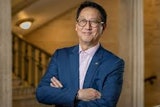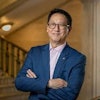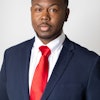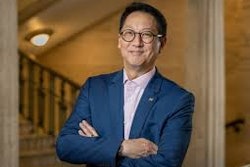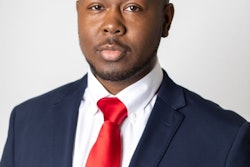Janelle Gill is confident that she has a future in jazz. The
eighteen-year-old freshman pianist began jazz performance studies last
semester at Howard University. Since then, she has played in the
school’s big band and the small-group jazz ensembles.
Gill is a graduate of the Duke Ellington School of the Arts in
Washington, D.C. She cites jazz pianists Theolonius Monk, Bud Powell,
Art Tatum, and Mary Lou Williams as some of her chief influences. As a
music education major at Howard, Gill expects to develop her piano
skills to the point where she can comfortably earn a living in
professional jazz — by performing, recording in the studio, and
teaching.
“I’ve always wanted to have a career in music,” Gill says. “Howard
has a decent program. They have a lot of talent in their faculty.”
Hundreds of young musicians such as Gill enroll in colleges,
universities, and music conservatories each year in the hope of
obtaining the jazz training necessary to become full-time
professionals. For decades, these institutions have been providing
fertile ground for the support and survival of jazz.
Although jazz education typically begins years before a student
gets to these institutions, more and more collegiate programs are
becoming vital links between professional hopefuls and the music
community they aspire to join.
“A student who comes to us is already a highly accomplished
musician,” says Dr. Arthur Dawkins, director of jazz Studies at Howard
University. “The majority of the students at Howard aim to be
performing full-time as musicians.”
Jazz represents one of the truly great world musical traditions to
develop in the United States. Its roots draw from both African and
European influences. Although early on in its development the music was
often used for dancing, eventually jazz became the medium for small
ensembles that performed in both nightclubs and concert halls.
A Beat That Moves
It was perhaps inevitable that a music so widely popular and
accepted would eventually find a home on American college and
university campuses.
Since its beginning, jazz has been on the move. It has migrated
across a considerable societal distance — from the fringes of society
to a central place in American culture. And despite its humble origins
in the South, the music flourished and became a truly national
phenomenon by the 1930s, aided by the emergence of touring big bands
and radio.
As early as the thirties, a number of historically Black colleges
and universities (HBCUs) in the South sponsored developmental jazz big
bands. Tuskegee University was a leader among these institutions.
Starting in the late forties, jazz programs at predominantly White institutions began sprouting around the country.
According to Dr. Bill Lee, the former executive director of the
International Association of jazz Educators, by the late forties and
fifties, jazz education was still struggling for acceptance in the
academy. Music departments, which were dominated by classical music
teachers, initially resisted the inclusion of jazz in the music
curriculum.
“Over time, jazz became respected in an academic sense,” Lee says.
“Initially, jazz instructors contended with the jealousy of classical
music faculty.”
All that has changed. Some observers say that collegiate programs
began filling a void left by the demise of jazz-oriented nightclubs —
which, for decades, functioned as training venues for young musicians
— and the decline in popularity of big bands.
Currently, some 200 institutions now offer programs in jazz
performance. While many are based in the conservatories, the majority
of jazz programs reside in college and university music departments.
Institutions where jazz enjoys a high priority include New York
University, the New School for Social Research, Indiana University, the
University of Northern Colorado, and Howard University. Conservatories
with thriving jazz programs include the New England Conservatory of
Music, the East-man School of Music, and Oberlin Conservatory of Music.
Dr. Scott Deveaux, a music historian at the University of Virginia,
said the jazz infrastructure has changed. At one time, aspiring
professionals would become involved with local bands in the hope of
being recruited to play in a national band. The local jazz groups were
known as “territory bands” and many were based in Black communities.
The new infrastructure is a tapestry of institutions — public schools, colleges, universities, and music conservatories.
Dr. Willie Hill, president-elect of the International Association
of jazz Educators, says that there were many more outlets for young
musicians to learn their craft back in the thirties and forties than
there are now. He believes that today it is critical to have
instruction begin in the public schools.
“I feel very encouraged by public schools that teach jazz history
and performance,” Hill says. “We’ve been going through ups and downs in
public schools with jazz education. Now there’s a resurgence in
attention being paid to jazz. The climate is right for increasing jazz
instruction in the public schools”.
The Music Makers’ Teachers
“Teaching is my way of giving back. That’s what it is all about,”
says Chico Hamilton, a jazz faculty member at the New School for Social
Research. “In the beginning I got help from other musicians. I’m just
doing what they did for me.”
Hamilton, a veteran jazz drummer and band leader who teaches
courses in improvisation and rhythm, has been at the New School since
its jazz program began. He says collegiate jazz programs are critical
for exposing young musicians to formats such as the big band, which now
constitute a tiny niche in the professional music community.
“The era of the big band is over,” Hamilton says. “Schools are almost all that we have left.”
The gradual absorption of jazz by the academy over the past fifty
years has attracted hundreds of jazz musicians, like Hamilton, who have
become teachers. Ironically many of them did not have the opportunity
to develop their craft in any kind of academic setting. A number of
prominent musicians from the forties and fifties turned to higher
education as a venue to impart their skills. Some are still active as
faculty members or guest instructors.
Composer and saxophonist Jimmy Heath is another prominent jazz
veteran who joined the university teaching ranks while in the latter
stages of a long, distinguished career. He has played with greats Such
as Dazzy Gillespie and Miles Davis, and has composed dozens of works
“It was important to reach to continue the music that I love,”
Heath says. “I wanted to help young people continue the tradition.”
After a decade of teaching, Heath retired from the faculty at
Queens College in New York City. In early January, Queens College —
along with the help of entertainment luminaries such as Bill Cosby —
paid a special musical tribute to Heath at New York City’s Lincoln
Center.
“I think it’s positive,” that colleges and universities got into
the business of teaching Jazz, says Heath, who also notes with pride.
“I have had students who are now professionals and are making a living
from their music.”
Cecil Bridgewater, a veteran jazz trumpeter and faculty member at
the New School for Social Research, says that colleges and universities
have been eager to recruit experienced musicians who may not have
graduate degrees into jazz faculty positions. Jazz program
administrators appreciate that many veteran musicians were active in or
close to the creation of jazz styles such as bebop in the 1940s,
according to Bridgewater.
Improvising the Curriculum
When jazz education began making its way onto higher education
campuses, a number of musicians expressed doubts that the music could
be taught in an academic setting. The problem, as they saw it, was
improvisation — a key part of jazz performance. Skeptics believed that
improvisation was a skill attainable only by rigorous practice with
working musicians. The college campus, they said, would provide little
of the intense practice and performance environments needed for shaping
young musicians into skilled improvisors.
“There was criticism of the effort to teach jazz in the colleges. But then there’s criticism of everything,” says Heath.
Over the years, a rough consensus on the jazz curriculum has
emerged among programs around the nation. Howard University’s Dawkins
says jazz performance programs should concentrate on teaching the
history of jazz, teaching composing and arranging, and helping students
develop their improvisational skills.
In order to earn a degree from the New School for Social Research’s
Mannes College of Music, undergraduates in the jazz and Contemporary
Music program are required to complete courses such as “Jazz Harmony
and Theory,” “History of jazz,” “Improvisation Ensemble,” and “Piano
Proficiency.”
Launched in 1986, the New School for Social Research’s jazz program
is one of the largest in the country, with more than 200 students.
Trumpeter Roy Hargrove is among the program’s alumni.
Bridgewater says the goal of the program is to prepare students “to
function in the jazz community.” He stresses that a good jazz program
needs to have experienced and working musicians involved with students
as teachers. He contends that weaker programs tend to rely upon faculty
whose members may have solid academic credentials, but lack
professional working experience as musicians.
“You can teach skills such as improvisation in an academic
setting,” says Bridgewater. “it can be done as long as students are
getting the right information. It doesn’t matter where they get it; it
matters whether they’re getting the right information.”
New York, New York
After spending a year at a college in Hartford, Conn., Matt
Hilgenberg grew convinced that he would have to move to New York City
to become a professional jazz musician. The trumpet player transferred
to New York University (NYU) as an undergraduate and stayed to pursue
graduate studies in music.
“[New York] is a very healthy environment for musicians,” says Hilgenberg.
While many college jazz programs around the country push off-campus
professional playing opportunities for their students and enlist
professional musicians to teach, few regions of the country can compete
with New York-area schools in terms of access to clubs, the best
musicians, and recording opportunities. In some respects, New York of
the 1990s has the same lure for young musicians as it had between the
1930s and the 1960s — when jazz greats such as Miles Davis routinely
left their homes and resettled in New York.
New Orleans, the birthplace of jazz, is also considered a good city
for young, aspiring jazz students looking to get professional playing
experience. Several of the colleges and universities there also offer
jazz performance programs.
Hilgenberg, a native of the Boston area, is currently the graduate
assistant for NYU’s jazz program. The twenty-two-year-old plays
professionally with a number of groups around the city, including an
Afro-Cuban big band. Last semester, he played in another Afro-Cuban
jazz ensemble comprised of NYU students, which was one of several NYU
jazz bands to perform at a regular Tuesday night gig at the Violet Cafe
in Greenwich Village.
The Violet Cafe is owned by NYU but managed by a restaurant
company. It has become, over the past few years, a performance venue
for NYU’s musical groups. Hilgenberg, who coordinated NYU jazz group
performances at the cafe last semester, says the Tuesday night gig
gives NYU jazz musicians the opportunity to experience the conditions
that musicians normally experience in jazz clubs.
“This is as close to the real club experience as you can get,” Hilgenberg says.
Although Casey Benjamin was offered a full scholarship to the
Berklee College of Music, in Boston, he turned it down to remain in the
New York area where he has lived much of his life. A sophomore at the
New School for Social Research, Benjamin stayed in New York to take
advantage of the city’s impressive jazz scene.
“It was the faculty that attracted me to the New School. Being in
New York gives you a great opportunity to network,” he says.
Benjamin, a saxophonist, aspires to have a career similar to that
of composer and media entrepreneur Quincy Jones, who built his career
around the success of being an accomplished jazz musician. Benjamin
believes having skills in jazz composing, producing, writing, and
performing will enable him to branch out into other music and fields
such as film production.
HBCUs Doing More With Less
While jazz education programs have blossomed all over the country,
a number of HBCUs have managed to develop and maintain quality programs.
Dr. Ira Wiggins, director of jazz studies at North Carolina Central
University (NCCU), says it would be easier to maintain quality if the
university granted more resources to the program. Currently, Wiggins —
a saxophonist and flutist — is the only full-time faculty member in
the school’s jazz program. The program has four ensembles — including
a big band, two combos, and a vocal jazz ensemble.
Despite being understaffed, NCCU’s jazz groups have, in recent
years, received top honors at numerous music festivals. NCCU groups
claimed dominance at the Villanova jazz Festival in Philadelphia and
the Count Basie jazz Festival at Hampton University in Virginia.
Additionally, the NCCU jazz Ensemble performed at the Montreux jazz
Festival in Switzerland and at Euro-Disney in Paris in 1996. And last
month, the NCCU jazz Combo and Vocal jazz Ensemble played in
Washington, D.C., at a White House reception which was hosted by
President Bill Clinton.
Wiggins — who praises schools such as the University of Miami and
Indiana University for investing heavily in jazz education — says the
jazz program staffing shortage at NCCU is not unique among HBCUs. He
believes that one reason for the shortage is that HBCUs are typically
more accustomed to devoting so much of their resources to their
high-profile marching bands.
“The support of marching bands keeps the primary focus on sports
rather than the music,” Wiggins says. “You don’t want to neglect the
music.”
Howard University’s Dawkins is optimistic about the overall growth
of jazz education across higher education, but worries that HBCUs are
not keeping up with wealthier and predominantly White schools in
supporting jazz programs. Like Wiggins, Dawkins says HBCUs place a high
priority on supporting marching bands. He believes that programs, such
as the one at Howard, can enable Black institutions to continue having
a leadership role in the development of jazz musicians if schools
recognize the music’s increasing popularity.
“The audience for jazz is there and it’s going to grow. It’s coming from university communities and suburban areas,” he says.
The Shape of Things to can
Melvin Butler, a PhD. candidate in ethnomusicology at NYU, was
among the estimated 6,000 people who attended this month’s annual
International Association of jazz Educators (IAJE) conference in New
York. There, he held an audience in awe of his saxophone playing skills
during a performance by the NYU Ensemble. Concert Jazz The young
musician plays both saxophone and flute in the ensemble.
Butler, who holds a masters degree in jazz performance from NYU,
believes he has a bright future ahead of him as both a music scholar
and a professional musician. While writing and researching extensively
about jazz and Caribbean music, he plays professionally, and recently
recorded an album with a septet led by jazz drummer Brian Blade.
Butler says that as an African American musician playing with some
of the most talented young players in the business he sees himself
fitting squarely in the tradition that Black musicians have established
in developing jazz. But he would like to see more African Americans
studying and earning undergraduate and graduate degree in jazz studies.
“As a musician, I see that many of the top players are African
American. But in academia, you don’t see that many Blacks as teachers
and students. It’s overwhelmingly White Butler says.
In addition to allowing young musicians such as Butler to showcase
their skills, the IAJE meeting, the largest ever for the 8,000 member
organization, gave students, teachers, and working musicians, many of
them affiliated with colleges and universities, time to network and
learn from one another.
Judging from the attendance estimates and the exuberant spirit of
conference attendees, the conference seemed to confirm the belief that
jazz education is growing and finding greater acceptance both in the
U.S. and overseas.
“The music is more widely known and appreciated now than it has been in the past,” says IAJE’s Hill.
RELATED ARTICLE: Jazz Program at Institutions of Higher Education
NORTHEAST
University of Massachusetts-Amherst Westfield State College
University of Lowell New England Conservatory of Music Berklee College
of Music University of New Hampshire Hartford Conservatory University
of Hartford Fairfield University William Paterson College of New Jersey
Jersey City State College Rowan College of New Jersey Princeton
University Rutgers University New York University New School for Social
Research Manhattan School of Music Purchase College Long Island
University The Brooklyn Conservatory of Music Queens College-CUNY Five
Towns College Skidmore jazz Institute SUNY-College of Fredonia Eastman
School of Music Ithaca College The College of Saint Rose
MID-ATLANTIC
Duquesne University School of Music California University of
Pennsylvania Indiana University of Pennsylvania Moravian College East
Stroudsburg University of Pennsylvania University of the Arts School of
Music Temple University West Chester University Howard University
University of Maryland Montgomery College-Rockville Towson State
University Catonsville Community College Morgan State University
Shenandoah University James Madison University Virginia Union
University Virginia Commonwealth University Hampton University Virginia
Tech Radford University West Virginia University
SOUTH
University of North Carolina-Greensboro University of North
Carolina-Chapel Hill North Carolina Central University East Carolina
University University of North Carolina-Asheville University of South
Carolina Georgia State University University of Georgia University of
North Florida Florida State University Seminole Community College
University of Miami Florida International University University of
South Florida Wallace State Community College University of Alabama
Auburn University Middle Tennessee State University University of
Tennessee University of Memphis University of Southern Mississippi
University of Louisville University of Kentucky
MIDWEST
Capital University Ohio State University Bowling Green State
University Oberlin Conservatory of Music University of Akron Youngstown
State University University of Cincinnati Indiana University University
of Michigan Wayne State University Oakland University C.& Mott
Community College Michigan State University Central Michigan University
Western Michigan University Grand Rapids Community College Interlochen
Arts Academy University of Northern Iowa Southwestern Community College
University of Iowa University of Wisconsin-Madison University of
Wisconsin-Stevens Point University of Wisconsin-Eau Claire University
of Wisconsin-Indianhead Arts & Education Center Lawrence University
Music Tech-Musicians Technical Training Center University of
Minnesota-Minneapolis University of Minnesota-Duluth Northern Illinois
University Northwestern University Illinois Benedictine College
American Conservatory of Music Roosevelt University-Chicago Musical
College Columbia College Chicago Bloom School of Jazz DePaul University
Kennedy-King College University of Illinois at Chicago Augustana
College Southern Illinois University-Edwardsville Milliken University
Southern Illinois University-Carbondale Webster University Central
Missouri State University University of Missouri-Kansas City University
of Kansas Emporia State University Bethany College Northeast Community
College
SOUTH CENTRAL
Loyola University College of Music University of New Orleans
University of Southwestern Louisiana McNeese State University Southern
University Jazz Institute Collin County Community College Stephen F.
Austin State University University of Texas-Arlington Weatherford
Community College Texas Christian University University of North Texas
Houston Community College-Westchester Lamar University Bee County
College of Music Southwest Texas State University University of
Texas-Austin
WEST
University of Denver Naropa Institute University of Colorado-Boulder
University of North Colorado Northwest College Casper College
University of Idaho University of Utah Mesa Community College Arizona
State University University of Arizona Northern Arizona University
University of Nevada Musicians Institute California State
University-Los Angeles University of Southern California El Camino
College Los Angeles Music Academy California State
University-Northridge California Institute of the Arts Harrison School
of Music San Diego State University University of Redlands San
Bernardino Valley College Fullerton Community College California State
University-Bakersfield Cuesta College California Polytechnic State
University Fresno City College Foothill College Stanford University
California State University-Hayward Los Medanos College University of
California-Berkeley Sononla State University DeAriza College Cabrillo
College San Jose State University Columbia College
NORTHWEST
Mt. Hood Community College Clackamas Community college University of
Oregon Cornish College of the Arts Shoreline Community College Western
Washington University Whitworth College
Source: Jazz Times October 1997
COPYRIGHT 1998 Cox, Matthews & Associates
© Copyright 2005 by DiverseEducation.com
